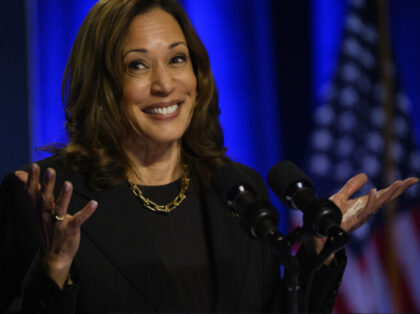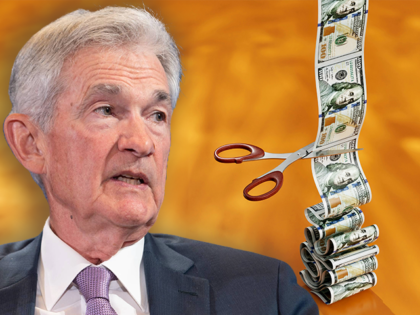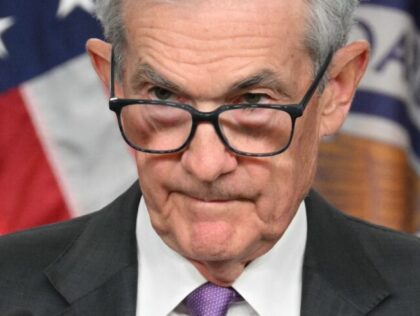Breitbart Business Digest: Vance Is Right on Immigration and Home Prices
There really should not be much controversy over the idea that a surge in immigration puts upward pressure on home prices.

There really should not be much controversy over the idea that a surge in immigration puts upward pressure on home prices.

CLAIM: Tim Walz claimed in the debate with J.D. Vance on Tuesday that the trade deficit under Donald Trump was the largest in history.

The longshoremen strike that began Tuesday is at its heart a labor protest against the disastrous inflation brought on by the reckless Biden-Harris economic policies.

Jimmy Carter was the first American president to lose his bid for re-election due to inflation.

State and local government jobs and construction jobs accounted for the majority of the increase.

A second Trump presidency is likely to unleash an explosion of economic growth that could surprise financial markets and officials at the Federal Reserve.

The Fed chair is still convinced monetary policy is highly restrictive.

Vice President Kamala Harris attempted to transition her public image from a leftwing progressive to a pragmatic, pro-business candidate this week, deploying a barrage of falsehoods and misleading statements but very little policy detail in a speech at the Economic Club of Pittsburgh.

Core inflation may have become embedded at a high rate, raising questions about further progress on restoring price stability.

Four years ago, President Joe Biden and Vice President Kamala Harris took control of the White House by campaigning on lies about the state of the economy under Donald Trump.

The growth of orders placed with American factories for durable goods stagnated in August, casting a shadow on claims by Vice President Kamala Harris that the Biden-Harris administration’s policies have bolstered U.S. industrial strength. The value of durable goods orders

One of the least discussed but most obvious realities of modern trade is that Donald Trump is, in his rough-hewn way, mostly right about tariffs, while the accepted wisdom mouthed by the media, think tanks, and economists for public consumption is, if not wrong, at least incomplete.

The Penn Wharton Budget Model finds that the tax and spending plans of Kamala Harris have twice as much drag on the economy.

The Goldman Sachs economists did not estimate that Trump’s policies would cause a recession or shrink the economy.

Kamala Harris has re-energized Democratic hopes to win the White House and is gaining ground on economic issues that were Donald Trump’s biggest advantage earlier this year.

Consumers are much less happy with current conditions and more pessimistic about what’s coming.

Fed officials now think it will take a higher rate to sustainably achieve two percent inflation.

The rise of Kamala Harris in national political polls has come at a cost of deteriorating optimism among U.S. businesses.

We have discovered something that the supporters of Kamala Harris and Donald Trump agree on: the Federal Reserve’s half-point interest rate cut this week was a political gift to Harris.

Contrary to the president’s claim, Biden appointed Powell to lead the Fed for a second term in 2021 and has met with the chair multiple times.

The Federal Reserve’s decision on Wednesday to begin lowering interest rates raises the question of how fast rates should be expected to decline.

Fed policy is not formally on the ballot in November, but interest rates over the next four years may turn on the results of the election.

Fed officials now see more unemployment and less inflation this year and next year.

As the Fed prepares to cut rates again, it’s worth remembering that rate cuts are never free, even when they seem like an easy fix. For the market, it’s always fun while it lasts, but the reckoning is rarely far behind.

U.S. industrial production increased by much more than expected in August, providing an unexpected source of strength for the U.S. economy alongside consumer spending even as the labor market has softened. Industrial production—a broad measure of factory, mining, and utility
![Operating a hand drill at the North American Aviation, Inc., [a] woman is in the control s](https://media.breitbart.com/media/2024/09/GettyImages-1410636577-e1726580745232-420x315.jpg)
U.S. consumers unexpectedly increased their spending in August, defying predictions that a softening labor market would drag down retail purchases. Retail sales rose by 0.1 percent in August and the prior month was revised up to a 1.1 percent gain,

If the Biden-Harris administration’s policies are not hurting the economy, why are prominent Democrats urging the Federal Reserve to announce a super-sized interest rate cut?

New York’s manufacturing sector expanded in September for the first time in nearly a year.

Someone call in the vice principal for student discipline! The market is bullying the Federal Reserve again.

A growing partisan divide pushed consumer sentiment higher despite the economy seeming worse to Republicans and independents.

At Tuesday’s debate, Vice President Harris did everything she could to talk around the most important question of this election.

Another landmark for the Biden-Harris administration.

A slightly hotter than expected inflation figure for August is the latest reminder that the Fed has not yet restored price stability.

While the well-behaved financial media outlets pinned the sell-off in stocks on Wednesday morning on the unexpected increase rise in core inflation, the severity of the moves in equities and bonds indicates something more is at work.

Stocks fell hard the morning after the Harris-Trump debate.

Inflation was stuck at an elevated level for a second straight month, raising worries that it may not be cooling as fast as thought.

It has been much higher under Biden-Harris.

Consumer prices barely rose during Donald Trump’s presidency, even after the president imposed tariffs.

Harris falsely described Trump’s tariffs as a sales tax.

Here are some of the key facts about the economy under the Trump administration and the Biden-Harris administration that should inform tonight’s debate.
